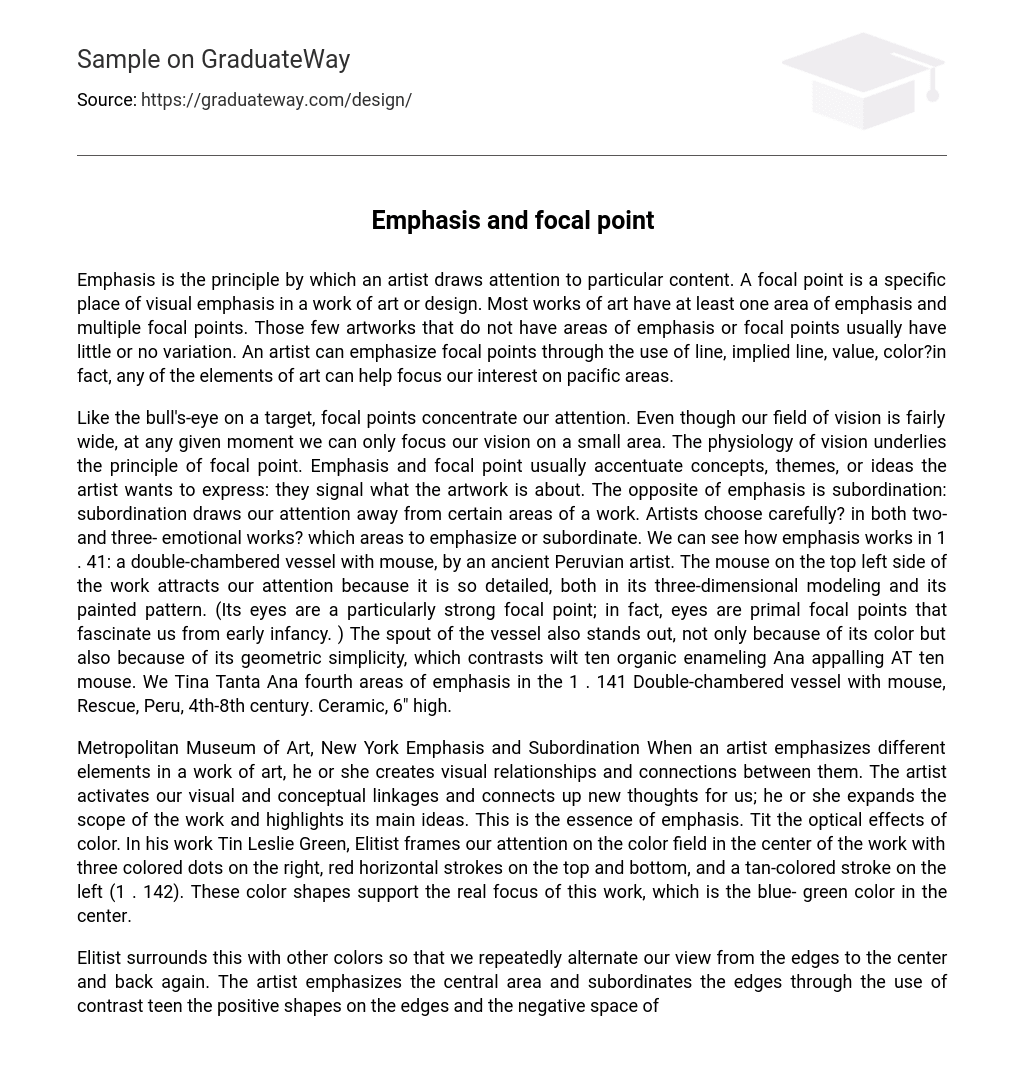Emphasis is the principle by which an artist draws attention to particular content. A focal point is a specific place of visual emphasis in a work of art or design. Most works of art have at least one area of emphasis and multiple focal points. Those few artworks that do not have areas of emphasis or focal points usually have little or no variation. An artist can emphasize focal points through the use of line, implied line, value, color?in fact, any of the elements of art can help focus our interest on pacific areas.
Like the bull’s-eye on a target, focal points concentrate our attention. Even though our field of vision is fairly wide, at any given moment we can only focus our vision on a small area. The physiology of vision underlies the principle of focal point. Emphasis and focal point usually accentuate concepts, themes, or ideas the artist wants to express: they signal what the artwork is about. The opposite of emphasis is subordination: subordination draws our attention away from certain areas of a work. Artists choose carefully? in both two- and three- emotional works? which areas to emphasize or subordinate. We can see how emphasis works in 1 . 41: a double-chambered vessel with mouse, by an ancient Peruvian artist. The mouse on the top left side of the work attracts our attention because it is so detailed, both in its three-dimensional modeling and its painted pattern. (Its eyes are a particularly strong focal point; in fact, eyes are primal focal points that fascinate us from early infancy. ) The spout of the vessel also stands out, not only because of its color but also because of its geometric simplicity, which contrasts wilt ten organic enameling Ana appalling AT ten mouse. We Tina Tanta Ana fourth areas of emphasis in the 1 . 141 Double-chambered vessel with mouse, Rescue, Peru, 4th-8th century. Ceramic, 6″ high.
Metropolitan Museum of Art, New York Emphasis and Subordination When an artist emphasizes different elements in a work of art, he or she creates visual relationships and connections between them. The artist activates our visual and conceptual linkages and connects up new thoughts for us; he or she expands the scope of the work and highlights its main ideas. This is the essence of emphasis. Tit the optical effects of color. In his work Tin Leslie Green, Elitist frames our attention on the color field in the center of the work with three colored dots on the right, red horizontal strokes on the top and bottom, and a tan-colored stroke on the left (1 . 142). These color shapes support the real focus of this work, which is the blue- green color in the center.
Elitist surrounds this with other colors so that we repeatedly alternate our view from the edges to the center and back again. The artist emphasizes the central area and subordinates the edges through the use of contrast teen the positive shapes on the edges and the negative space of the center. When a work does not have areas of emphasis, that changes the way we respond. For example, the painting Blue Interior by Mark Toby (1890- 1976) has an overall implied texture so uniform that we are hard-pressed to find places where our eye can rest (1 . 143). Toby, who grew up in the Pacific Northwest, was inspired by the landscape near his native Seattle.
He wishes to provide us with a sense of the Upset Sound area, with (as the artist says) its “virginal winds, air currents, and intermingled seasons. ” He is especially interested 1 . 42 Jules Elitist, Tin Leslie Green, 1964. Acrylic and oil/wax crayon on canvas, 10’10” x 6’10”. Museum of Fine Arts, Boston, Massachusetts 1 . 143 (right) Mark Toby, Blue Interior, 1959. Tempera on card, 44 x 28″ decorations on the two chambers of the vessel. Although these areas have a great deal of variety, they connect because they share common shapes, coloration, and texture that draw our attention away from the undecorated?subordinated? areas of the vessel. The playful variations of emphasis create a sense of humor and imagination.





